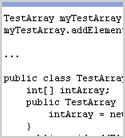KnowledgeCenters Java KnowledgeCenter Java Courses
During normal program execution in Java, the caller method calls the worker method, the worker method performs an action and the execution returns to the caller method. When an exception occurs, an exception is thrown and either a special Exception object is passed to a special method-like catch block in the current method or execution returns to the caller method. Classes are grouped into packages to ease the management of the system. To deploy a Java application, you put the necessary files into a JAR file. A major performance penalty is paid in two-tier client/server. The three components or tiers of a three-tier client/server environment are presentation, business logic or functionality, and data. They are separated so that the software for any one of the tiers can be replaced by a different implementation without affecting the other tiers. This course provides an overview of error handling, and covers propagation of exceptions, catching and throwing exceptions, and multiple exceptions and errors. Packages, JARs and deployment, two-tier and three-tier architecture, and modifications and enhancements to a sample application are also covered.
| Objectives |
|---|
Error Handling and Deploying Applications in Java
|


